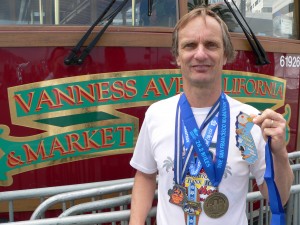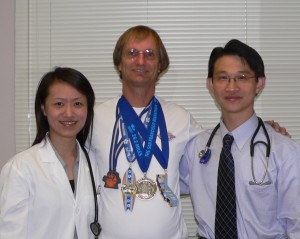In December, 2007, Pete Van Hamersveld (Class of ’92, M.A., sociology) was told on his 50th birthday that he had colon cancer. It had been discovered during a routine colonoscopy, and the resulting surgery revealed that the cancer had spread to his lymph nodes. Van Hamersveld had Stage 3C colon cancer, which is one level before a terminal diagnosis. That was in January 2008, and throughout more than a year’s worth of chemotherapy, radiation, and a second surgery, he decided to take on a regimen of physical conditioning that included running–thus entering a race to save his life literally and figuratively.

“When I was going through chemo, I was given a lot of material by the American Cancer Society,” says Van Hamersveld, who is the associate director of Institutional Research, Assessment, and Planning at California State University, Dominguez Hills. “Some of it indicated that you should start exercising when you’re on chemo to help your appetite and keep up some levels of energy, so I started walking a mile everyday. After a few weeks, I got to the point where I could slowly jog that mile and kept improving. It took me six months, but on the morning of my last chemo session, I ran two and a half miles.”
Van Hamersveld’s training was not without its difficulties.
“One of the side effects I developed at the end of six months of chemotherapy was neuropathy in my feet and sometimes I would fall when I was running,” he says. “It got bad enough to prevent me from running for several weeks until I got over that. Later, a different chemotherapy I got during radiation treatments warned against foot damage that could occur from activities like running, so I had to stop again.”
In February 2009, Van Hamersveld underwent another surgery to reconnect his colon, during which he stopped running one last time. After recovering for another six weeks, he decided to pick up where he left off.
“By about mid-April, I started to jog again,” he says. “I’ve also read in the research for some cancers that vigorous exercise might actually help fight off recurrence. I thought to myself, ‘I’m going to keep doing this.’ And I decided it would be really great if I could run an entire marathon, which is 26.2 miles long.”
Eight months after his second surgery, Van Hamersveld ran the 2009 Long Beach International City Bank Marathon. Using the American Cancer Society‘s Website, he created a page for a fundraiser that he named “Fighting Cancer, One Step at a Time.” He reached his goal of raising $2,600, half of which came in after he posted a photo of himself finishing the marathon, which he did in five hours and 55 minutes, just under the six-hour limit.
“My only goal was to finish [the marathon],” recalls Van Hamersveld. “I was pretty close to [completing] my treatment to be doing something like that. During the last few miles I could feel the cramps setting in and I didn’t want to jeopardize my goal, so it got to the point where I decided I could walk the last stretch and still make it.”
Encouraged by his victory, Van Hamersveld decided to take on the California Dreamin’ Racing Series. Participants who complete all three marathons within two years qualify for the series medal. Van Hamersveld completed all three within ten months.
Although still recovering from the Long Beach race and the after-effects of his cancer treatments, his second race in the series was the 2010 Surf City USA Marathon in Huntington Beach in February. Then this past July, Van Hamersveld completed the series with the 2010 San Francisco Marathon.
“I ran an hour and eight minutes faster than the first one,” he says of his time in the Surf City USA Marathon, which he finished in four hours and 47 minutes. “This time I never stopped to walk and was in better condition then. I finished so early that my family wasn’t at the finish line yet. I borrowed someone’s phone and called them to say I was already done.”
For the San Francisco Marathon, considered one of the most difficult marathons in California, he almost matched his Surf City race time, coming in at four hours and 48 minutes.
“Running a marathon is about suffering through it,” he says. “Even now after going out for my regular six-mile run I realize I still haven’t fully recovered from San Francisco. One of the hills was actually marked as a 31.5 percent incline. I was already in pain at nine miles and it got worse as I kept going. I ran the whole time and my pace was pretty consistent throughout the whole race. My last three miles was the fastest pace.”
While preparing to run the marathons, Van Hamersveld also picked up the pace in his everyday life and returned to his job at the university in September 2008 while still undergoing radiation treatments and chemotherapy.
“It made me feel great to do the normal thing again – driving to work on the busy freeway, seeing my coworkers, and basically just getting back to as normal a routine as before,” he says. “I even valued Mondays just as much as Fridays, although I have to admit I’m starting to regress in this area.”
Van Hamersveld says that the outpouring of concern and support from his colleagues and supervisors was also part of the healing process.
“We have a lot of caring people in our campus community,” says Van Hamersveld. “Many told me they were praying for me and in many different languages – I’m glad God is multicultural. One faculty member told me she has a regular prayer list and that I’m at the top of it. When another faculty member told me he ‘sent a little prayer up’ for me, I thanked him and said that I didn’t know he believed in such things. He replied, ‘Well, I usually don’t, but just in case.’ That really meant a lot to me. While I was on my first chemo regiment, the administration was great, and accommodated me by having me work from home whenever I felt well enough via a virtual personal network.”

Although Van Hamsersveld’s diversion of running was a key to his recovery, he had the expected psychological battles to fight as well. He says that he was plagued with cancer-related dreams in the beginning and was astounded by the rate at which the cancer had spread to his lymph nodes, since just five years prior he had had a clear colon exam.
“When my surgeon first told me the results of the pathology report indicating that the cancer spread to five lymph nodes resulting in Stage 3C, it was a scary hit,” he says. “For the first few months, I was obsessed with my odds – I do work with numbers. I tried to deal with my situation by reminding myself that I’ve had a pretty good life and realized that lots of people get cancer so I shouldn’t feel singled out or particularly unlucky.”
Another of Van Hamersveld’s concerns when he was diagnosed was for his children.
“My daughter was only 11 at the time and my son was 15,” he says. “It really bothered me to think of them being so young and [possibly] losing their father. I also remember reasoning that I didn’t want to miss out on the life that I still had for fear of what I may not have in the future.”
Van Hamersveld hopes that his story will encourage people to be more aware of the possibility of colon cancer–especially beginning at age 50–and the steps that can be taken to prevent it from spreading.
“My hope is that hearing about my experience will raise awareness of the need to get proper screening in a timely manner and not ignore any symptoms in between, even if previously tested and cancer was once ruled out,” he says. “I especially want people to be aware that the most common symptom of colon cancer is no symptoms at all.”
Van Hamersveld says he plans on finishing his fourth marathon in a year by running in the Long Beach Marathon again next month and possibly entering the Los Angeles Marathon in March 2011. He says that while he is tested every three months and so far has shown no signs of the cancer recurring, he does not look very much beyond short term plans.
“When I get tested and it works out, well the marathons–these are milestones,” he says. “Before the cancer, I never ran more than five miles at a time in my whole life. Now I’m setting lifetime distance records. What I would never have believed during those first difficult months after my diagnosis is that just two years later I would be in the best physical conditioning of my life, having completed three marathons in ten months and with hope for a cancer-free future.”
“Running a marathon is fun and while I’m running, I’m really thankful that I can even do it. It’s my way of celebrating that I’m still healthy.”